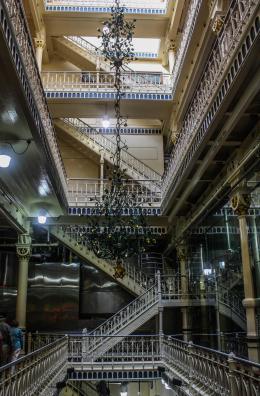Upon exiting the gorgeous Union Station, one of the five most beautiful train stations in the world, the humidity on this steamy early afternoon in St. Louis hit me like a saturated mop. Although I’m not a huge beer fan, I had the sudden urge to throw back a cold one. So I decided to go right to the source and hopped in my car for the short drive to the Anheuser-Busch Brewery, a massive complex of 189 structures situated on 142 acres about three miles away.
The brewery’s free daily tours begin outside, where a couple of Clydesdales were munching on their vegetarian lunch. These powerful and beautiful draft horses used to pull beer wagons in the 1800s, but now they lead a pretty privileged life, judging by their healthy appearance and their crib: a stately red-brick building constructed in 1885, with roomy stables (with stained-glass windows) running along the circumference of a circular interior that’s occupied by old-fashioned beer wagons and trucks. A few horses (one of whom was named Scott) were inside, escaping the heat and taking it easy, relishing their role as the iconic symbol of AB and the stars of some very memorable television advertisements, particularly during the annual Super Bowl.
The rest of the tour weaves its way into and around some of the other buildings for almost an hour, offering a rather fascinating look into the beer-brewing industry and this National Historic Landmark District. Opened in 1852 by Eberhard Anheuser and his son-in-law, Adolphus Busch, the 21st of 22 children (and buried in nearby Bellefontaine Cemetery, the brewery made the most of its advantageous site next to rail lines and the Mississippi River and in the midst of an area with a large German population, who certainly knew more than their fair share about bier. Like a small city, the complex’s red-brick Romanesque buildings (three of which were added to the National Register of Historic Places in 1971) with crenellated towers, gargoyles, and elaborate details line named streets. “Budweiser” is spelled out in large letters atop the massive seven-story Packaging Plant from 1917, and the Malt House, from 1898, features a lovely rounded corner. Now the administration building as well as a museum housing about 400 historical items, the Old Lyon Schoolhouse was built in 1868 for the education for AB’s employees’ children.
I found the Brew House, completed in 1892, particularly attractive, with giant clock faces on the sides of its soaring corner tower. Inside, I admired the multi-story chandeliers that were cleverly forged into an entanglement of hops-bearing vines, the intricate ironwork all along the staircases around the sunlit atrium, and the abundant natural light shining on the mash tanks.
The tour traces its way through the seven-step brewing process and touches on everything from ingredients to fermentation to packaging in the bottling area, where countless bottles on conveyor belts wend their way around an enormous workspace like the longest snake imaginable. Despite the age of the buildings, the technology is state-of-the-art, and I was impressed by the complexity of the machinery and the processes that are involved in the entire cycle.
As the tour progressed, we stopped to look at about three dozen colossal tanks. The guide tossed out this little numerical tidbit: If you drank one bottle of beer every hour, 24 hours a day, it would take you 137 years to empty one of these tanks.
We finished the tour in the Hospitality Room, where guests can choose two generous samples from a diverse menu. I opted for a Shock Top Lemon Shandy, which went down like water, and a Bud Light Lime, which I nursed a little longer. If I had to determine whether the tour was a success (which it was) solely by the number of times people shouted “Prost!” and tapped glasses, I’d say this tour was a wise choice, and not just if you’re thirsty.




